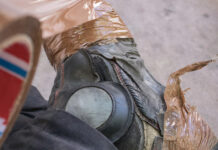A microscopic fungus causes athlete’s foot. It lives on dead tissue of the hair, toenails and outer skin layers. Most commonly found in men from the teenage years to the early 50’s, it thrives in warm, moist environments such as footwear and socks. The fungus may also be fostered in the floors of public showers, locker rooms and swimming pools. It can be transmitted through contact with a cut or abrasion on the bottom surface of the foot. The infection causes raised, circular pimples or blisters that resemble ringworm lesions.
Athlete’s foot most often just takes the form of persistent itching of the skin on the sole of the foot or between the toes. If the infection worsens, the skin grows soft and inflamed with the edges of the infected area becoming milky white.The skin begins to peel. If the peeling skin worsens, large cracks develop in the skin, which can possibly lead to secondary bacterial infections where the infection can be transmitted to other parts of the body by scratching, or contamination of clothing or bedding.
Another form of athlete’s foot is often called “moccasin foot” where a red rash spreads across the lower portion of the foot in the pattern of a moccasin. The skin in this region gradually becomes dense, white and scaly. If a series of raised bumps or ridges under the skin on the bottom of the foot is formed, it is called inflammatory or vesicular, and the itching is intense with less peeling of the skin. Similar outbreaks may occur on the hands, a response of the immune system to fungal antigens (antibodies that fight the fungal infection.
As anyone who has suffered from athlete’s foot knows, these infections may disappear spontaneously or persist for years. The best results usually are obtained with early treatment before the fungal infection firmly establishes itself. Two medications that are sold over the counter are Lotrimin and Absorbine Jr. These are to be applied topically and massaged into the skin. These medications combat further fungal growth and reproduction. If the problem persists, seeing a doctor or Podiatrist is recommended. Prescription are available such as Lamisil and Naftin, to combat the more stubborn infections. In most cases, 4 to 6 weeks of treatment clear up the infection. If the infection becomes systemic, stronger antifungal medications such as Fulvicin and Grisactin may be prescribed. If the infection is bacterial, a course of oral antibiotics may be prescribed.
Alternate pairs of shoes daily. Let one pair dry out while you wear another. Remove footbeds if possible. Working Person’s Store sells many boots and shoes with removable footbeds. We also have boot dryers available.
If your feet sweat a lot, putting some bath powder that contains corn starch or sodium bicarbonate on them each morning may help.
Make sure you change your socks daily.
Use “athletic socks” specially made to wick away moisture and help regulate temprerature with special fabrics. To help with that, WPS carries Athletic Socks featuring Coolmax, andAthletic Socks with Duraspun.




